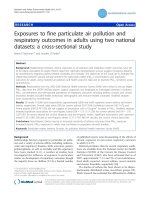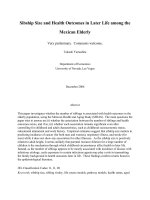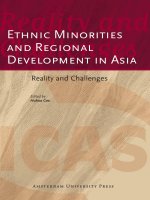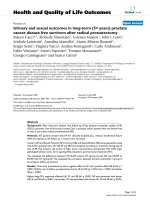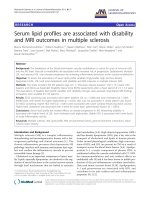Birth weight ethnic differences and health outcomes in childhood
Bạn đang xem bản rút gọn của tài liệu. Xem và tải ngay bản đầy đủ của tài liệu tại đây (1010.76 KB, 156 trang )
BIRTH WEIGHT: ETHNIC DIFFERENCES AND
HEALTH OUTCOMES IN CHILDHOOD
JEANNETTE LEE
MBBS, BMed Sci, FRACGP
A THESIS SUBMITTED
FOR THE DEGREE OF DOCTOR OF MEDICINE
DEPARTMENT OF COMMUNITY, OCCUPATIONAL
AND FAMILY MEDICINE, YONG LOO LIN SCHOOL
OF MEDICINE
NATIONAL UNIVERSITY OF SINGAPORE
2005
i
ACKNOWLEDGEMENTS
My deepest appreciation to my supervisor, Professor David Koh who provided
ongoing encouragement, support and advice for this thesis. His motivation and
support has not only encouraged me to complete this thesis but to venture into the
world of academia.
I am also grateful for the support of Associate Professors Chia Kee Seng and Chew
Suok Kai and Drs Derrick Heng and Stefan Ma for their collaboration in this research
project. Many thanks also to the Singapore National Registry of Births and Deaths,
the Central Claims Processing System and the Singapore Cancer Registry. This thesis
would certainly not exist without their kind assistance and permission to use the data.
Also many thanks to Mr Cheung Kwok Hang, who so very kindly and patiently
assisted in the preparation of the data, and Doris for your editing help.
My friends and colleagues of COFM, who have provided much support,
encouragement and a wonderful work environment throughout the years.
My dear husband Kit Min for his loving, kind and steadfast support, and our children
Shu-Wen and Wei-Sheng for being the mostly wonderful children they are.
My dear parents, brothers and sister for their never ending love and support
My precious Lucky dog, who has always given me his unconditional love.
And finally to my daughter, Lauren Chye Shu-Lin, you are the one who inspired and
spurred me to finish this thesis before your arrival into this world.
ii
TABLE OF CONTENTS
ACKNOWLEDGEMENTS i
TABLE OF CONTENTS ii
SUMMARY x
LIST OF TABLES xiii
LIST OF FIGURES xv
LIST OF APPENDICES xvi
LIST OF MANUSCRIPTS, PUBLICATION AND PRESENTATIONS xvii
CHAPTER 1 INTRODUCTION AND GENERAL OBJECTIVE 1
CHAPTER 2 GENERAL BACKGROUND 3
2.1. FACTORS THAT AFFECT BIRTH WEIGHT 3
2.2. EPIDEMIOLOGICAL RESEARCH USING RECORD LINKAGE OF
NATIONAL REGISTERS 5
2.2.1. Introduction 5
2.2.2. Advantages of register-based data 5
2.2.3. Limitations of register-based data 6
2.2.4. Summary 8
iii
2.3. DATA LINKAGE IN SINGAPORE 8
2.3.1. Introduction 8
2.3.2. Birth certificate/National Registration Identity Card Number (NRIC) 8
2.3.3. National Registers 9
2.3.4. Linkage of national registers 13
2.3.5. Data privacy and confidentiality 13
CHAPTER 3 ETHNIC DIFFERENCES IN BIRTH WEIGHT AND INFANT
MORTALITY
14
3.1. BACKGROUND 14
3.1.1. Introduction 14
3.1.2. Asian Indians and low birth weight 14
3.1.3. Differences in infant mortality between ethnic groups and the “low
birth weight paradox”.
17
3.2. OBJECTIVES 19
3.3. METHODS 20
3.3.1. Data linkage 20
3.3.2. Cohort selection 20
3.3.3. Variables 20
iv
3.3.4. Outcome 21
3.3.5. Data analysis 21
3.4. RESULTS 23
3.4.1. Characteristics of the three ethnic groups 23
3.4.2. Variables associated with moderately low birth weight 26
3.4.3. Infant Mortality 29
3.5. DISCUSSION 33
3.5.1. Summary 33
3.5.2. Birth weight and infant mortality of the ethnic groups 33
3.5.3. “Fetal origins” hypothesis and further research 35
3.5.4. Strengths and limitations 36
CHAPTER 4 EFFECT OF LOW BIRTH WEIGHT AND PREMATURITY ON
SUBSEQUENT HOSPITAL ADMISSIONS IN CHILDREN
37
4.1. BACKGROUND 37
4.1.1. Introduction 37
4.1.2. Prospective short-term studies 37
4.1.3. Prospective long-term studies 38
4.2. OBJECTIVES 42
v
4.3. METHODS 43
4.3.1. Data linkage 43
4.3.2. Cohort selection 43
4.3.3. Variables 43
4.3.4. Outcomes 44
4.3.5. Data analysis 45
4.4. RESULTS 46
4.4.1. Hospitalization by preterm status and birth weight groups 46
4.4.2. Factors associated with hospital admission 48
4.4.3. Common admissions 50
4.5. DISCUSSION 53
4.5.1. Summary 53
4.5.2. Comparison of incidence rate of preterm births 53
4.5.3. Hospital admissions 54
4.5.4. Further areas for research: Non-hospital associated morbidity and
socio-economic and psychological impact 55
4.5.5. Possible preventive measures 56
4.5.6. Specific strengths and limitations 56
vi
CHAPTER 5 THE EFFECT OF BIRTH, MATERNAL FACTORS AND PRIOR
HOSPITAL ADMISSIONS FOR RESPIRATORY TRACT
INFECTIONS ON INCIDENT ASTHMA ADMISSION
58
5.1. BACKGROUND 58
5.1.1. Introduction 58
5.1.2. Birth weight and gestational age and risk of asthma 58
5.1.3. Infectious diseases and risk of asthma 62
5.1.4. Other risk factors for asthma that can be studied using data from the
registries in Singapore 64
5.2. OBJECTIVES 66
5.3. METHODS 67
5.3.1. Data linkage 67
5.3.2. Cohort selection 67
5.3.3. Variables 68
5.3.4. Outcome 68
5.3.5. Data analysis 69
5.4. RESULTS 70
5.4.1. Asthma admissions 70
vii
5.4.2. Univariate analysis of variables 70
5.4.3. Multivariate analysis of variables 71
5.5. DISCUSSION 74
5.5.1. Summary 74
5.5.2. Birth weight was not associated with IAA but gestational age is 74
5.5.3. Other factors associated with IAA 74
5.5.4. Areas for further research 76
5.5.5. Specific strengths and limitations 77
CHAPTER 6 BIRTH WEIGHT AND THE RISK OF EARLY CHILDHOOD
CANCER
79
6.1. BACKGROUND 79
6.1.1. Introduction 79
6.1.2. Birth weight and all cancers combined 79
6.1.3. Birth weight and leukaemia 80
6.1.4. Birth weight and other childhood cancers 80
6.1.5. Biological relationship between birth weight and childhood cancer 83
6.1.6. Studies of birth weight and childhood cancer in Asian populations 84
6.2. OBJECTIVE 85
viii
6.3. METHODS 85
6.3.1. Data linkage 85
6.3.2. Cohort selection 85
6.3.3. Variables 85
6.3.4. Outcomes 86
6.3.5. Data analysis 86
6.4. RESULTS 87
6.4.1. Childhood cancer in Chinese, Malays and Asian Indians 87
6.4.2. Types of childhood cancer 90
6.4.3. Factors associated with childhood cancer in Chinese children 91
6.4.4. Birth weight and specific cancers for Chinese children 93
6.5. DISCUSSION 96
6.5.1. Summary 96
6.5.2. Higher birth weight and risk of childhood cancer 96
6.5.3. Higher birth weight and risk of childhood leukaemia 96
6.5.4. Birth weight and the risk of other childhood cancers 98
6.5.5. Further research 98
ix
6.5.6. Specific strengths and limitations 99
CHAPTER 7 CONCLUSION AND RECOMMENDATIONS 101
7.1. RECOMMENDATIONS FROM STUDIES 101
7.2. RECOMMENDATIONS FOR NATIONAL REGISTERS 103
7.2.1. Suggested changes to existing registers 103
7.2.2. Assessment of quality of data 104
REFERENCES 107
APPENDICES 135
x
SUMMARY
Introduction
The effect of birth weight on infant survival and mortality is well established.
However its effect on morbidity outcomes, especially those in childhood is less clear.
The primary aim is to assess the effect of birth weight on infant mortality and
morbidity outcomes in early childhood. Secondary aims include assessment of other
birth and maternal characteristics on the same outcomes.
Methodology
Four prospective population-based linkage studies were conducted in Singapore.
Registers used include the Singapore National Register of Births and Deaths
(SNRBD), the Central Claims Processing System (CCPS) and the Singapore Cancer
Register (SCR). The unique birth certificate number was used to link records of
individuals between registers. All (or a subgroup of all) Singaporean children born
between 1
st
January 1992 and 31
st
December 2001 were used as the study population
for various components of this study. Each study had approximately 280,000-325,375
children that were followed-up.
Cox proportional hazards and logistic regression models were used in the data
analysis.
Birth and maternal characteristics included birth weight (500gms categories),
gestational age (weeks), gender (male/female), ethnic group (Chinese, Malay, Asian
xi
Indian or Others), birth order, maternal age and education. Birth weight was
subsequently grouped into different categories that were specifically justified for each
study.
Outcomes assessed included infant mortality, hospital admissions between 1-5 yrs of
age, incident asthma hospital admissions (IAA) between 0-5 yrs and cancer between
0-5 yrs. In general follow-up was up to the time of the event, death or date of
censoring. Person years (py) of follow-up ranged from 324,874-1,156,897 py in the
various studies.
Main findings
(i) The effect of birth weight on infant mortality has shown the existence of the
“low birth weight” paradox in Asian Indians but not Malay babies in Singapore. That
is, compared to Chinese, for term babies with birth weight 1500-2499gms, those of
Asian Indian origin had a decreased risk of infant mortality, whilst Malays had an
increased risk. However compared to Chinese, for babies with birth weight 2500-
3499gms and >=3500gms, those of Asian Indian origin appeared to have an increased
risk of infant mortality, whilst for Malays the infant mortality remained elevated for
these birth weight groups.
(ii) Both early gestational age and lower birth weights were associated with
increased rates of hospitalization in children between 1-5 yrs of age. A preterm baby
with birth weight 500-999gms had a 1.77 times (adjusted for ethnicity) increased risk
of being ever admitted compared to a preterm baby of birth weight >=2500gms.
(iii) Birth weight was not associated with incident asthma admissions for children
less than 2 years old or children 2-5 yrs of age
xii
(iv) High birth weight (>3499gms) was associated with a 1.5 times increased risk
of childhood cancer before 5 yrs of age in Chinese children.
The main secondary findings were an increased risk of incident asthma admissions for
children with recurrent respiratory tract infections, among Malay and Asian Indian
ethnic group and males.
Conclusion and recommendations
Birth weight has been shown to have ethnic differences. Low birth weight in
premature babies is associated with hospitalization whilst high birth weight is
associated with increased risk of childhood cancer in this cohort of Singaporean
children. However further epidemiological and biological studies are needed to
confirm these findings because of either limitations in data available or small number
of outcomes as is the case for childhood cancer. Given the evidence provided so far in
this and other studies, the control of birth weight is not advocated as a preventive
measure for either asthma or cancer and pregnant mothers should be encouraged to
have a healthy balanced diet and adequate exercise.
xiii
LIST OF TABLES
Table 2.1 Factors that have an independent effect on birth weight 3
Table 3.1 Studies of ethnic differences in birth weight between Asian Indians and
other ethnic groups
16
Table 3.2 Characteristics of Chinese, Malay and Asian Indian babies born at term
between 1
st
January 1992-31
st
December 2001 24
Table 3.3 Prevalence rates of term babies born VLBW, MLBW and in other birth
weight categories, by ethnic group
25
Table 3.4 Prevalence of MLBW within gestation and ethnic groups in term
babies.
26
Table 3.5 Prevalence of MLBW within gender and ethnic groups in term babies.
27
Table 3.6 Prevalence of MLBW within birth order and ethnic groups in term
babies.
27
Table 3.7 Prevalence of MLBW within maternal age and ethnic groups in term
babies.
28
Table 3.8 Prevalence of MLBW by maternal educational and ethnic groups in
term babies.
28
Table 3.9 Causes of death in the first year for Chinese, Malay and Asian Indian
and All ethnic groups combined.
30
Table 3.10 Infant mortality by ethnic groups, birth and maternal characteristics in
term babies.
31
Table 3.11 Infant mortality by birth weight categories for Chinese, Malays and
Asian Indians in term babies
32
Table 4.1 Long-term prospective studies of children born premature or with low
birth weight.
40
Table 4.2 Summary indices of admissions and days spent in hospital by birth
weight groups for children ever admitted between 1-5 years of age.
47
xiv
Table 4.3 Children who had three or more admissions or whose total hospital stay
was equal to or greater than 7 days between 1-5 years by birth weight
groups.
47
Table 4.4 Admission rate by each year of age between 1-5 years of age 48
Table 4.5 Incidence of ever being admitted between 1-5 years of age for birth and
maternal characteristics.
49
Table 4.6 Adjusted risk for ever being admitted by term status for different birth
weight groups between 1-5 years of age 50
Table 4.7 Number and rate of admissions for the most common main ICD-9
groups for admissions between 1-5 years of age.
51
Table 4.8 Incidence and risk of ever being admitted for respiratory tract diseases
between ages 1-5 years for preterm children by birth weight groups.
.52
Table 5.1 Studies that excluded children who were very low birth weight,
extremely premature, or had congenital diseases and that assessed the
effect of birth weight on childhood asthma
60
Table 5.2 Rates of incident asthma admissions for children born between 1
st
January 1992-31
st
December 1997 70
Table 5.3 Variables that were significant in univariate analysis and adjusted in a
multivariate model for incident asthma admission between 0-<2 years
72
Table 5.4 Variables that were significant in univariate analysis and adjusted in
multivariate model for incident asthma admission between 2-5 years of
age.
73
Table 6.1 Population-based studies of different childhood cancers 81
Table 6.2 Cancer incidence by ethnic and gender groups for children born
between 1
st
January 1992-31
st
December 1998 88
Table 6.3 Number of cancers in children born between 1
st
January1992-31
st
December 1998 and followed-up till 5 years of age, death or censor at
31
st
December 1999 89
Table 6.4 Types of cancer found in Chinese, Malays and Asian Indians 90
Table 6.5 Association of all childhood cancer with birth and maternal
characteristics for Chinese children
92
Table 6.6 Risk of leukaemia and lymphoma by birth weight categories for
Chinese children.
94
Table 6.7 Risk of other cancers by birth weight categories for Chinese children95
xv
LIST OF FIGURES
Figure 3.1 ICD-9 category codes used in the Singapore National Registry of
Births and Deaths.
29
Figure 6.1 Distribution of cancers between 0-5 years of age for children born
between 1
st
January 1992-31
st
December 1998 for Chinese, Malays and
Asian Indians.
89
xvi
LIST OF APPENDICES
Appendix 1 Variables available in the Singapore National Registry of Births and
Deaths
135
Appendix 2 Variables available in the Singapore Cancer Register 137
xvii
LIST OF MANUSCRIPTS, PUBLICATION AND
PRESENTATIONS
Papers from this study
Lee J, Chia
KS, Chia SE, Hughes H, Cheung KH, Koh D. Ethnic differences in birth
weight and infant mortality amongst Chinese, Malay and Asian Indian term singletons
in Singapore. Paed Perinat Epidemiol (manuscript submitted)
Lee J; Ma S; Chia KS; Cheung KH; Heng D, Chew SK, Koh D. Effect of low birth
weight and prematurity on subsequent hospital admissions in children between 1-5
years of age in Singapore. Eur J Pub Health (manuscript submitted)
Lee J, Heng D, Ma
S, Chew
SK, Chia KS, Koh D. The effect of respiratory tract
infections, birth weight and gestational age on incident hospital admissions for asthma
between birth and 5 years of age. Paed Perinat Epidemiol (manuscript submitted)
Lee J, Chia KS, Cheung KH, Chia SE, Lee HP (2004). Birthweight and the risk of
early childhood cancer among Chinese in Singapore. Int J Cancer. 110, 465-467.
xviii
Oral presentations
Presentations made at the 39
th
Singapore Malaysian Medical Congress, Singapore on
3nd July 2005
Lee J, Ma S, Heng D, Chew SK, Chia KS, Koh D. “The effect of pre-maturity and
birth weight on subsequent hospital admissions in children between 1-5 years of age
in Singapore”
Lee J, Heng D, Ma S, Chew SK, Chia KS, Koh D. “Prior hospital admissions for
respiratory tract infections and subsequent incident hospital admission for asthma
between birth and 5 years of age”
1
CHAPTER 1 INTRODUCTION AND GENERAL OBJECTIVE
The observation of association between birth weight and disease was perhaps the most publicized by
the “thrifty hypothesis” of DJ Barker for ischaemic heart disease in adults (Barker et al., 1989). This
hypothesis stems from the belief that in-utero effects may play a role in the development of diseases
in later life. Prior to this the focus of birth weight was predominantly on survival very early in life.
Recently more research has also been conducted on mortality and morbidity outcomes ranging from
respiratory, to cardiovascular and cancer outcomes; in childhood and adulthood. This thesis focuses
on outcomes in infancy and early childhood
Register-based data linkage research can be a useful tool to determine the effects of factors on
outcomes collected in population registry data bases. In particular, the use of population registers for
prospective follow-up is ideal for cohort studies as it greatly minimizes the biases associated with
smaller epidemiological studies. However it is dependent on the content and quality of the databases,
and this may vary between registries and for different outcomes. All relevant information may not be
available and the standardization may differ within and between some registers. Nevertheless such
research can be useful indicator of possible associations that may demand further attention.
Singapore is a city state with a population of approximately 3.5 million residents and is comprised of
three main ethnic groups. Chinese, Malays, Asian Indians and other ethnic groups represent 76.7%,
13.8% and 8.3% and 1.7% of the population respectively (Health Information Management Branch,
2004). The social and political stability has allowed the establishment of nationwide registries that
collect socio-economic and health data. Health services are also well-developed with affordable and
equitable access for the majority of the population. Thus Singapore a good location to conduct
population-wide register based research
2
Using the population-based national registers available in Singapore, the general objective of this
study is to determine the effect of birth weight on mortality and morbidity outcomes in childhood
3
CHAPTER 2 GENERAL BACKGROUND
2.1. FACTORS THAT AFFECT BIRTH WEIGHT
There are many known factors that can influence birth weight. These have been previously
extensively studied in different populations worldwide. A detailed assessment and meta-analysis of
43 determinants of low birth weight by Kramer states “factors with well-established direct causal
impacts on intrauterine growth include infant sex, racial/ethnic origin, maternal height, pre-
pregnancy weight, paternal weight and height, maternal birth weight, parity, history of prior low
birth weight infants, gestational weight gain and caloric intake, general morbidity and episodic
illness, malaria, cigarette smoking, alcohol consumption and tobacco chewing” (Kramer, 1987). The
effects of these factors are summarized in Table 2.1. Although these factors are known to affect birth
weight, they may not necessarily also affect the outcomes of interest for the following studies and
are thus not all considered as confounders.
Table 2.1 Factors that have an independent effect on birth weight
Factors Effect
Infant sex Males tend to have higher BW than females
Racial/ethnic origin Blacks, Indians and Pakistanis have lower BW than Europeans
Maternal Height Positive association with BW
Pre-pregnancy weight Positive association with BW
Paternal weight and height Possible positive association but less effect than maternal size
Maternal BW Positive association with BW
Parity Positive association with BW but may not be so for multi-paras
History of prior low BW infants Positive association with BW
Gestational weight gain/caloric intake Positive association with BW
General morbidity and episodic illness Possible positive association with BW
Malaria Possible inverse association with BW
Cigarette smoking Inverse association with BW
Alcohol consumption Inverse association with BW
Tobacco chewing Inverse association with BW
Summary of factors assessed by Kramer et al., 1987, Birth weight (BW)
4
Birth weight and gestational age are two common measures that are used to assess maturity at birth.
In a normally developing and healthy fetus, gestational age correlates in a positive and linear manner
with birth weight (Robertson, 1999). Opinions differ as to which measure should be used. Although
it makes biological sense to consider gestational age with birth weight as a consequence of this,
many researchers have used birth weight as the measure of maturity primarily because of availability
and reliability of data. Also, it is well recognized that gestational age that is determined by the
woman’s last menstrual period may not be particularly precise .The majority of collaborative
networks thus report data in terms of birth weight (Ward et al., 2003).
However some investigators believe that the use of birth weight is inappropriate because it can lead
to the misclassification of babies that although small, are more mature and that these differences in
maturity and growth results in a misleading protective effect of intrauterine growth retardation
(Arnold et al., 1991). Thus restricting or stratifying by gestational age allows for better assessment of
the proportion of babies who are small but not necessarily premature. Thus it has been generally
recommended to assess the effect of birth weight restricted to babies born at term as the effect of
gestational age at this stage is minor (Wilcox, 2001). This is particularly important for studies that
assess the affect of fetal growth and retardation on clinical outcomes and survival. However from a
public health perspective birth weight can be used to determine resource requirements for the
different birth weight groups. Thus the literature is mixed in the use of either birth weight or
gestational age.
5
2.2.1.
2.2.2.
2.2. EPIDEMIOLOGICAL RESEARCH USING RECORD LINKAGE OF
NATIONAL REGISTERS
Introduction
Population-based epidemiological studies utilizing record linkage have been used for several
decades in countries that have nationwide registers that collect information on general demographic
factors as well as health indices. These include the Nordic countries, USA and UK. This data is often
termed as “secondary” in comparison to primary data collected by the use of traditional
epidemiological methods.
Advantages of register-based data
The strengths of using registry-based data can be seen especially in the comparison of methods used
in cohort studies. Gissler et al commented that, “follow-up studies have generally been based on
costly ad hoc cohort studies with detailed information collected specifically for research purposes on
a certain group of people” whilst “the increasing collection of routine health data provides an
alternative method of gathering follow-up data” (Gissler et al., 1998).
The use of register-based data can also enable long-term follow-up for cohort studies. For example,
Gissler et al discuss the importance of long-term follow-up in monitoring the health of children,
whereby “among young children, future problems may be more important than immediate health
status. In addition, long term follow-up is especially needed for studies on risk factors for diseases
and special social, health or educational needs.” Furthermore “most longitudinal data has been on
mortality and data on diseases have been derived from cross-sectional or ad hoc follow-up studies”
and “health monitoring is hampered by incomplete or discontinuous data collection”(Gissler et al.,
1998). Thus it is possible using secondary data sources to cover the entire population and sample
6
2.2.3.
size is only limited to the size of the (usually very large) data base and budget for computer
processing.
Other advantages are that whereas primary data collection relies upon initial contact of individuals
and their subsequent co-operation to participate with the study, secondary data collection does not
require actual contact with individuals (Roos et al., 1987). This eliminates problems such as initial
participation and subsequent tracking of individuals on follow-up, except for those who have left the
jurisdiction. The reactivity of research that may occur when individuals are aware of the study is also
eliminated, thus reducing recall bias for either pre- or post-event histories.
Limitations of register-based data
The benefits of utlizing registers are based on certain assumptions; that health care data are of high
quality; that information on individuals should be linkable across data sets; that individuals in the
database should be traceable through time to provide longitudinal follow-up (Roos et al., 1987).
The type and quality of data collected may also vary. Unfortunately some but not all desired
information may be available, unlike in primary studies whereby the investigator may choose to
collect comprehensive information. For example birth certificates may state birth weight but not
gestational age. Also, birth weight may not be entered as an exact number but within predetermined
categories. Other information such as antenatal care and maternal diseases may not be recorded.
The data that is available may also not be accurately recorded. This is more likely to occur for fine
distinctions between diagnoses of diseases rather than obvious major disease groups, or death. The
registration of diseases is dependent upon patient presentation and contact with medical care. Also
for some registries, no uniform set of tests or investigations are done for the diagnosis and the

